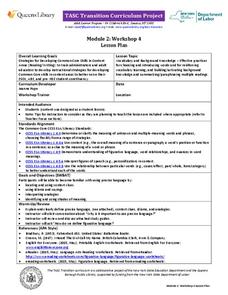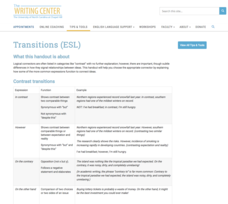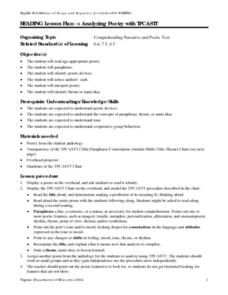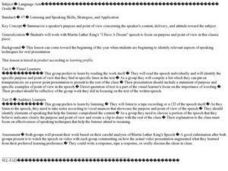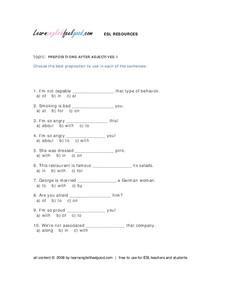EngageNY
Analyzing Images and Language: Inferring about the Natural Disaster in Eight Days
Pictures often reveal different meanings. Scholars analyze the images in Eight Days and discuss how they add meaning to the text. Readers answers questions about how specific colors are used to create different emotions. Learners then...
Curated OER
The Pillsbury Doughboy
Mourning the death of the Pillsbury Doughboy (from a yeast infection and pokes in the belly), this presentation discusses the use of puns, metaphors, and polysemes. The slide show continues by discussing other popular metaphors and...
Curated OER
Figurative Language
Students create a PowerPoint show illustrating two types of figurative language. They demonstrate understanding of personification by creating and interpreting simple examples. They also demonstrate understanding of alliteration.
Curated OER
Effective Literary Analyses
Twelfth graders discuss a fictional text that they are given, they identify passages, which highlight the author's style, language naances and textual ambiguities. Pupils brainstorm possible topics for an analytical essay, they are...
New York State Education Department
TASC Transition Curriculum: Workshop 4
Why is it important to use precise language? Participants explore this question in the fourth activity in a series of 15 on effective instruction. Perfect for all content areas, the activity promotes appropriate language choice through...
Curated OER
Know Before You Go: Anticipating and Previewing Difficult Texts such as The Bluest Eye
Support your scholars with these anticipatory questions to go along with The Bluest Eye by Toni Morrison. The objective, rationale, and teacher instructions are clearly explained, followed by an anticipation guide for pages 81-93 and the...
Curated OER
Punctuation 2: Other than Commas
Thoroughly cover the nuances of apostrophes, quotation marks, dashes, hyphens, colons, and semi-colons. Intended for higher-level English classes, the examples given pertain to tricky rules and formal language. There are no animations or...
National Endowment for the Humanities
Kate Chopin's The Awakening: Local Color in the Late 19th Century
Kate Chopin's The Awakening introduces readers not only to the lush Louisiana setting of Grand isle but also to the nuances of Creole culture. the second lesson in a three-part series examines how Chopin's use of literary realism and...
Curated OER
Even
Delve into the more nuanced parts of grammar with this ESL worksheet. Students work with the word "even" in ten different questions, which provide sentences in different contexts. They choose whether or not to use the word, and in what...
Curated OER
Literature and Humor
From Canterbury Tales to The Odd Couple, this presentation details the different treatments of humor in different literary formats. Numerous authors and works of literature are represented here as examples of satire, irony, comedy, and...
Curated OER
Introduction to Legal Citation
A good resource for law students who need some help with citation, this presentation covers many key points from the ALWD Citation Manual. The nuances of legal citation, such as typeface, numbers, and primary sources, will become...
Curated OER
Grammar Practice: Choosing Between Fewer and Less
When should you use "fewer" instead of "less?" Reinforce this grammatical nuance in your class with this handy reference sheet. A short explanation guides students through the process of choosing one word over the other, and a series of...
Read Theory
Analogies 2 (Level 8)
Examine nuances in word meanings with an exercise based around word analogies. Learners use the sentences and frames provided to help them determine the relationships between words. They complete 10 analogies.
English Grammar
Gerund or Infinitive – Fill in the Correct Form
Middle schoolers love listening to music, and they also love to listen to music. So what's the difference? Spell out the nuanced ways to use gerunds and infinitives with a 50-question grammar exercise. Given short sentences and verbs,...
University of North Carolina
Transitions (ESL)
When it comes to comparing and contrasting in an essay, looking at a chart and picking a random transition word may not do the trick. As explained in an informational writing handout, the words writers use to move from one idea to...
Curated OER
Close Reading
Eleventh graders read and study Hamlet. Then they are introduced to close reading as a means of understanding what is being read--not only understanding the printed word, but also the nuances and connotations of language as it is used by...
Shmoop
ELA.CCSS.ELA-Literacy.L.11-12.5
"Timid, scared, terrified." High school scholars examine words, their denotations and connotations, in a series of exercises that use lines from Shakespeare to explore figurative language and word relationships. Participants then...
LearnEnglishFeelGood.com
Correct Word Order in English
Syntax is important when learning to speak English, and a worksheet with ten sentences can assist English learners in putting words in the correct order. As they read each sentence, they choose which of two answers would be most...
Curated OER
Analyzing Poetry with TPCASTT
Middle schoolers read a poem and complete a TPCASTT chart. They make a prediction about the title (T) , paraphrase each line (P), identify poetic devices and nuances (C-connotation), explore mood and tone (A-attitude), point out shifts...
Curated OER
Martin Luther King's "I Have a Dream"
Dr. Martin Luther King's "I Have a Dream" speech provides the text for a study of how to analyze a speaker’s content, delivery and attitude. Visual learners identify specific lines that reveal King’s purpose and point of view while...
LearnEnglishFeelGood.com
Simple Present or Present Continuous?
Mastering verb tense is an important part of building your learners' reading skills. Young grammarians look over ten sentences and use context clues to decide whether they should use the present or present progressive tense.
LearnEnglishFeelGood.com
Prepositions After Adjectives
Practice reading context clues with a set of ten sentences within a grammar worksheet. As they examine each sentence, readers choose which preposition would be most appropriate after the adjective shown.
LearnEnglishFeelGood.com
Count or Non-Count Nouns?
Many learners struggle with the difference between count and non-count nouns. When do you use a few or a little? Or much or many? Take a look at ten sentences where young grammarians can...
LearnEnglishFeelGood.com
Fewer or Less?
When do you use fewer, and when do you use less? Learn the difference between the two words with a fill-in-the-blank worksheet that asks readers to make their choice based on the context clues in the ten sentences.






